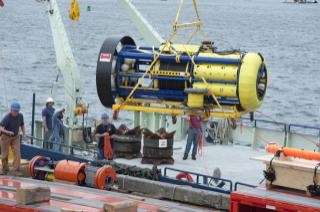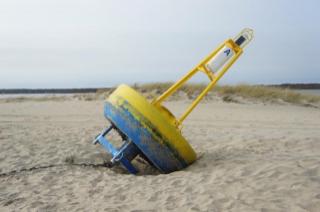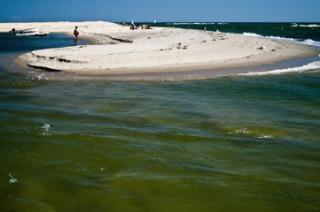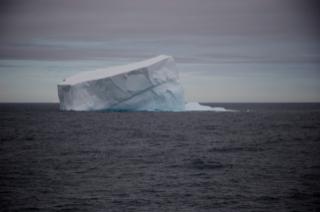Woods Hole Oceanographic Institution (WHOI)
2012
With Cape Wind hoping to break ground in the coming years and a huge new swath of ocean opened for wind farm development south of the Vineyard, the impact of turbine noise on fisheries is still poorly understood.
“The long-term impacts of these wind farms are just totally unknown,” said Woods Hole Oceanographic Institution biologist Scott Gallagher this week.
2011
The waters south of the Vineyard will soon become among the best studied in the world. At the continental shelf break, some 80 miles south of South Beach where North America begins its descent toward the abyssal plain, a huge swath has been identified by scientists to be monitored, dissected and measured in resolutions and over time scales unprecedented in oceanography.
A scientific buoy was among the flotsum that washed up on South Beach when the remnants of Hurricane Irene passed over the Island two weeks ago. Susan Snider found the Woods Hole Oceanographic Institution buoy on last Sunday and submitted the photograph to the Gazette.
Janet Fredericks, an operations manager for the institution, wrote and said it was a guard buoy, a marker used to alert and keep vessels away from the underwater scientific gear beneath. The institution maintains a sub-sea observatory along with a shoreside weather observatory.
This month scientists from the Woods Hole Oceanographic Institution will descend on Edgartown with a sonar-equipped waverunner to map, in unprecedented resolution, the ever-shifting sands and currents of Katama Bay. While the bathymetry of the body of water, where change is a constant feature, is of special scientific interest to the Woods Hole scientists, the information is even more valuable for the surprising underwriter of the project: the U.S. Department of Defense.
2010
Six weeks ago, as the oil giant BP sought to rehabilitate its reputation after the Gulf of Mexico oil spill, the company announced it would put $500 million into scientific research into the effects of the spill. Now, it appears that money may not be forthcoming.
And that has thrown into disarray plans involving the Woods Hole Oceanographic Institute (WHOI), as well as other scientific organizations looking to study the long-term consequences of the blow-out of the Deepwater Horizon drilling rig.
Think Antarctica and you think snow. A vast and unending, featureless panorama of it.
Andrew McDonnell, a PhD student at the Woods Hole Oceanographic Institution and MIT, traveled to the Palmer U.S. Research Station in Antarctica to see snow, but not on land. Instead Mr. McDonnell was interested in the timeless undersea blizzard of particulate matter known as marine snow, the ghostly detritus of animals that descends the water column, sometimes taking months to reach the bottom.





